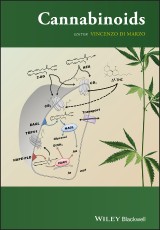Details

Cannabinoids
1. Aufl.
|
110,99 € |
|
| Verlag: | Wiley-Blackwell |
| Format: | EPUB |
| Veröffentl.: | 18.07.2014 |
| ISBN/EAN: | 9781118451274 |
| Sprache: | englisch |
| Anzahl Seiten: | 320 |
DRM-geschütztes eBook, Sie benötigen z.B. Adobe Digital Editions und eine Adobe ID zum Lesen.
Beschreibungen
<p>'Cannabinoids' is a broad term covering a group of natural products from Cannabis sativa, one of which locks on to specific receptors – protein molecules on the surface of cells – known as cannabinoid receptors. Over the past decades scientists have found that cannabinoid receptors and their endogenous ligands, the endocannabinoids, are involved in a vast array of physiological functions, including helping to control brain activity, energy metabolism, heart function, the immune system and even reproduction.</p> <p>In <i>Cannabinoids</i>, Vincenzo Di Marzo has assembled contributions from international experts to provide the definitive guide to what continues to be a rapidly developing research field. After an introductory historical chapter, the book continues by looking at the biochemical, genetic and molecular elements of cannabinoids, followed by chapters covering their role in health and disease. The final chapter outlines the need for a new nomenclature to reflect the complex and multi-disciplinary nature of this area.</p>
<p>List of Contributors xiii</p> <p>Preface xv</p> <p><b>1 Looking ahead after 50 years of research on cannabinoids 1</b><br /> <i>Raphael Mechoulam</i></p> <p>1.1 Summary 1</p> <p>1.2 Introduction 1</p> <p>1.3 Cannabidiol (CBD) 6</p> <p>1.4 Fatty acid amides of amino acids and related compounds 8</p> <p>1.5 Conclusions 10</p> <p>1.6 References 10</p> <p><b>2 Cannabinoid receptor intracellular signalling: The long journey from binding sites to biological effects 17</b><br /> <i>Lawrence C. Blume, Khalil M. Eldeeb and Allyn C. Howlett</i></p> <p>2.1 Historical progression: Serendipity to opportunity 18</p> <p>2.2 Significance of being a G protein coupled receptor (GPCR) 21</p> <p>2.3 CB1 cannabinoid receptor interactions with other cellular signals 23</p> <p>2.4 Functional role of CB1 receptor accessory proteins 25</p> <p>2.5 Opportunities: Pharmacotherapeutic insights based on cell signalling 33</p> <p>2.6 Concluding remarks 41</p> <p>2.7 References 41</p> <p><b>3 Endocannabinoid biochemistry:What do we know after 50 years? 53</b><br /> <i>Filomena Fezza and Mauro Maccarrone</i></p> <p>3.1 Introduction 54</p> <p>3.2 Endocannabinoids and related molecules 60</p> <p>3.3 Biosynthesis of endocannabinoids and related molecules 66</p> <p>3.4 Degradation of endocannabinoids 71</p> <p>3.5 Oxidative metabolism of endocannabinoids 77</p> <p>3.6 Conclusions and future perspectives 78</p> <p>3.7 References 83</p> <p><b>4 Genetic dissection of the endocannabinoid system and how it changed our knowledge of cannabinoid pharmacology and mammalian physiology 95</b><br /> <i>Beat Lutz</i></p> <p>4.1 Introduction: To set the stage 96</p> <p>4.2 Tool box for genetic dissection 97</p> <p>4.3 Understanding cannabinoid pharmacology 106</p> <p>4.4 Unravelling endocannabinoid system functions 113</p> <p>4.5 Caveats in genetics 124</p> <p>4.6 What have we learnt about cannabinoid pharmacology and mammalian physiology? 125</p> <p>4.7 Perspectives 127</p> <p>4.8 References 127</p> <p><b>5 Cannabinoids, endocannabinoids and stress 139</b><br /> <i>Cecilia J. Hillard, Qing-song Liu, XiaoQian Liu, Bin Pan, Christopher J. Roberts and Leyu Shi</i></p> <p>5.1 Introduction 140</p> <p>5.2 Regulation of endocannabinoid signalling by stress 143</p> <p>5.3 ECS regulation of the HPA axis response to stress 154</p> <p>5.4 ECS role in SNS responses to stress 159</p> <p>5.5 Stress and ECS in the periphery 161</p> <p>5.6 Summary 162</p> <p>5.7 References 163</p> <p><b>6 Cannabinoids and the brain: New hopes for new therapies 175</b><br /> <i>Javier Fernández-Ruiz, Mariluz Hernández and Yolanda García-Movellán</i></p> <p>6.1 Cannabinoids and the brain: A long journey together 176</p> <p>6.2 Brain processes and brain disorders investigated in relation to the endocannabinoid system 180</p> <p>6.3 Concluding remarks and future perspectives 202</p> <p>6.4 References 202</p> <p><b>7 Potential therapeutic applications of cannabinoids in gastrointestinal and liver diseases: Focus on Δ9-tetrahydrocannabinol pharmacology 219</b><br /> <i>Paolo Caraceni, Francesca Borrelli, Ferdinando A. Giannone and Angelo A. Izzo</i></p> <p>7.1 Introduction 220</p> <p>7.2 The endocannabinoid system in the gut and in the liver 220</p> <p>7.3 Potential therapeutic applications of cannabinoids in the gastrointestinal tract 221</p> <p>7.4 Potential therapeutic applications of cannabinoids in the liver 234</p> <p>7.5 Conclusions 245</p> <p>7.6 References 246</p> <p><b>8 Fifty years of ‘cannabinoid research’ and the need for a new nomenclature 261</b><br /> <i>Vincenzo Di Marzo and Luciano De Petrocellis</i></p> <p>8.1 An introduction to cannabinoid research and the ‘old’ nomenclature in this field (before the year 2000) 262</p> <p>8.2 ‘New’ nomenclature (after the year 2000) 269</p> <p>8.3 ‘Multi-target’ compounds 280</p> <p>8.4 Conclusions 281</p> <p>8.5 References 281</p> <p>Index 291</p>
<p><b>Vincenzo Di Marzo</b> is considered as one of the foremost authorities in cannabinoid research. He is a Research Director at the Institute of Biomolecular Chemistry of the National Research Council (ICB-CNR), Naples, Italy; coordinator of the Endocannabinoid Research Group in the Naples region; and an Adjunct Associate Professor in the Department of Pharmacology and Toxicology at the Medical College of Virginia at Virginia Commonwealth University in Richmond.</p>
Diese Produkte könnten Sie auch interessieren:

Alzheimer's Disease: Cellular and Molecular Aspects of Amyloid beta

von: J. Robin Harris, Falk Fahrenholz

213,99 €















